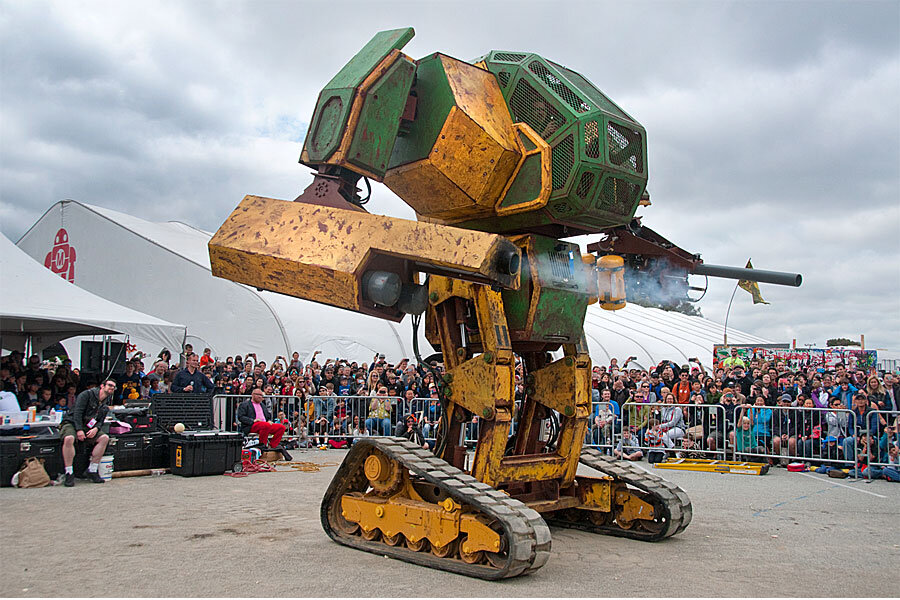Forget soccer. Can US beat Japan in a giant robot battle?
Loading...
Who would prevail in battle between giant robots, the United States or Japan? We may soon find out.
The founders of Megabots Inc, a Boston-based company that is seeking to build a giant, piloted robot for arena combat, has issued a challenge to their Japanese counterpart Suidobashi Heavy Industries, the manufacturer of the four-legged, piloted Kurata robot.
They readily accepted. "We can't let another country win this," said Suidobashi artist Kogoro Kurata, who developed his namesake robot along with roboticist Wataru Yoshizaki, in a video response. "Giant robots are Japanese culture."
Gui Cavalcanti, who last year co-founded Megabots with fellow engineer Matt Oehrlein, says in a phone interview that he was inspired by his love of video games, movies, and the concept of putting people into massive mechanical battle suits, nicknamed “mech suits.”
“Matt Oehrlein and I kinda grew up playing Mech Warrior and Battletech video games and watching all the really, really cheesy science fiction movies like 'Robot Jox,' " says Mr. Cavalcanti. "Mechs have been a part of science fiction culture for the last 30 to 40 years,”
“That’s what we grew up on. That’s what we love. At some point we said, ‘Well, we know how to build these really cool robots now. This is the science fiction future we were promised, so why not do this?'”
“It’s really a sport that requires high-end technology. Right now, we’ve roboticized [hydraulic] construction equipment as an affordable means of promoting the bigger idea of a giant robot sports league that would eventually be all high-end technology,” he says. “This battle is really a giant commercial for what this could be.”
Initially, they created just a torso and a right arm. They called their creation the Mark1.
“The campaign fell far short of its goal,” according to Cavalcanti. “Basically the message we received was ‘We’re not excited by this half a robot. We don’t think this could be a thing.' There was a lot of incredulity on the internet.”
So the team worked with Autodesk to use their software to make a simpler version of the robot for MakerFaire in San Mateo, California in May. To that end Autodesk ran a contest in February 2015 to design the armor paneling and arm cannon which were incorporated into the final design giving the MegaBot Mark II, as it became known, giant paintball guns.
But how would the Mark II fare in combat? There was only one way to find out.
“We had known about the Kurata robot for a while. [Suidobashi Heavy Industry had already created a mech warrior back in 2012.] If we want to start a battle we need a second robot and we could build one ourselves and then we just thought, well, there is another robot out there,” he says. “Maybe we could just challenge them. So we got this hair-brained idea and we just started. We recorded the movie.”
He adds that what he finds interesting is the way the robots have become a sort of East-meets-West philosophical and stylistic approach to combat.
“The funny thing is that both sides unintentionally, without thinking about it developed these Eastern vs. Western styles. All of the Mech Warrior series and Battlefront series are all just robots with guns on them with no hand-to-hand combat whatsoever. So that’s the style we emulated. Meanwhile, the Japanese style is very Gundam, very Eastern, very sculpted pretty looking with lots of like shields and swords and swords and fists. The guns are just sort of interesting-looking add-ons.”
Kurata also noted a stylistic difference, "Come on guys, make it cooler," he says in his video response. "Just building something huge and sticking guns on it. It's ... Super American."
Kurata and Suidobashi say they want a metal-on-metal melee, not paintballs.
“I’m not very nervous,” Cavalcanti says laughing. “I think it’s gonna be awesome! I mean there’s a significant likelihood that both robots will be significantly destroyed. That’s how it’s shaping up, but I think that’s OK. I think it’s worth it.
So will this be pay-per-view? Will it take place in America or Japan?
“We don’t know where or when yet,” he says. “We have to circle around with the Japanese and maybe find neutral ground to fight the robots in the most epic fashion possible. But it will be in about a year. It’s definitely on.”
To that end, Cavalcanti has a message for American robot experts and Battle Bot makers.
“If Grant Imahara [famous for being a BattleBot pioneer], Jamie Heinaman or Adam Savage the Myth Busters or anyone into science and technology on TV that we want your help to make this epic," Cavalcanti says. "Let’s do this.”








